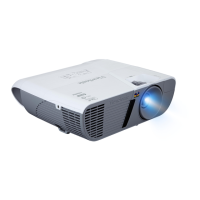33
This function is only available when the input signal is S-Video, Video, YPbPr (digital) or
YCbCr (digital).
Adjusting Tint
Go to the PICTURE > Advanced > Tint menu and press / .
The higher the value, the more reddish the picture becomes. The lower the value, the more
greenish the picture becomes.
This function is only available when the input signal is S-Video, Video, YPbPr (digital) or
YCbCr (digital).
Adjusting Sharpness
Go to the PICTURE > Advanced > Sharpness menu and press / .
The higher the value, the sharper the picture becomes. The lower the value, the softer the
picture becomes.
This function is only available when the input signal is S-Video, Video, YPbPr (digital) or
YCbCr (digital).
Adjusting Brilliant Color
Go to the PICTURE > Advanced > Brilliant Color menu and press / .
This feature utilizes a new color-processing algorithm and system level enhancements to
enable higher brightness while providing truer, more vibrant colors in the projected picture.
It enables a greater than 50% brightness increase in mid-tone images, which are common in
video and natural scenes, so the projector reproduces images in realistic and true colors. If
you prefer images with that quality, select a level that suits your need. If you don’t need it,
select Off.
Reducing image noise
Go to the PICTURE > Advanced > Noise Reduction menu and press / .
This function reduces electrical image noise caused by different media players. The higher
the setting, the less the noise.
This function is only available when a PC, Video or S-Video input signal is selected.
Selecting a gamma setting
Go to the PICTURE > Advanced > Gamma menu and select a preferred setting by
pressing / .
Gamma refers to the relationship between input source and picture brightness.
Selecting a Color Temperature
Go to the PICTURE > Color Temp. menu and press / .
The options available for color temperature settings vary according to the signal type
selected.
1. Cool: With the highest color temperature, Cool makes the image appear the most
bluish white than other settings.
2. Neutral: Makes images appear bluish white.
3. Normal: Maintains normal colorings for white.
4. Warm: Makes images appear reddish white.
Setting a preferred color temperature
1. Go to the PICTURE > Color Temp. menu.

